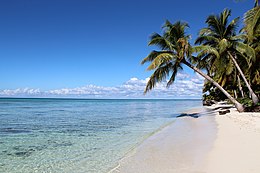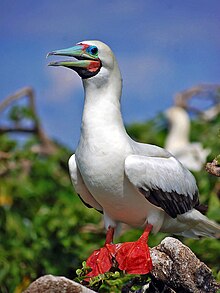geo.wikisort.org - Island
Saona Island (Spanish: Isla Saona) is a 110 square kilometer tropical island located off the south-east coast in Dominican Republic's La Altagracia province. It is a government-protected nature reserve and is part of Parque Nacional Cotubanamá.[1]
Native name: Isla Saona | |
|---|---|
 Saona Island | |
 Saona Saona Island (Dominican Republic) | |
| Geography | |
| Location | Caribbean Sea |
| Coordinates | 18°09′20″N 68°41′58″W |
| Area | 110 km2 (42 sq mi) |
| Length | 25 km (15.5 mi) |
| Width | 5 km (3.1 mi) |
| Coastline | 47 km (29.2 mi) |
| Highest elevation | 35 m (115 ft) |
| Administration | |
| Province | La Altagracia |
| Demographics | |
| Population | 300 |
| Pop. density | 2.73/km2 (7.07/sq mi) |
| Isla Saona Lighthouse | |
| Construction | concrete (tower) |
| Height | 12 m (39 ft) |
| Markings | white (tower) |
| Power source | solar power |
| Focal height | 32 m (105 ft) |
| Range | 16 nmi (30 km; 18 mi) |
| Characteristic | Fl W 10s |
There are two permanent settlements, the towns of Mano Juan and Catuano. Mano Juan is a fishing village with wooden houses and "Catuano beach" has a detachment of the navy.
The island is a popular destination for tourists from all over the Dominican Republic, who arrive in fleets of catamarans and small motorboats on organized excursions every day. It is known for its beaches, and has been used on a number of occasions by filmmakers and advertisers looking for a stereotypical "deserted island" setting for their film or product.
Such notable films include Pirates of the Caribbean (2003),[2] and The Blue Lagoon.[3]
Etymology
Granberry and Vescelius (2004) suggest a Macoris etymology for the name Saona, comparing it with sa-ona 'full of bats' in the purportedly related Warao language of the Orinoco Delta.;[4] However, it is widely accepted that Columbus named it after the Italian city of Savona (see below).
History
The island was baptized "Saona" by Christopher Columbus, who landed on it in May 1494[5] during his second voyage to the Americas. The name was meant "... to honor Michele da Cuneo, [Columbus'] friend from Savona."[6] Columbus named Michele da Cuneo the first governor of the island.[7]
By 1500, the Tainos on the island provided Santo Domingo with most of its cassava.[8]
Saona Island and Savona (now part of Liguria, northern Italy) still have twinning relationships. The small power plant in Saona Island is a gift of Savona.
Geography
The seas around the Island are rich in wildlife, with many species of birds and tropical marine fish, and there are large areas where natural sandbars offshore bring the depth to just a few feet. Smaller speed boats stop for tourists to relax in the waist-deep shallows where they snorkel, and explore the fields of starfish indigenous to the region.
Near and around Saona island are coral reefs ecosystems with impressive marine diversity that attract snorkelers and scuba divers alike.
Flora and fauna
There are 539 registered species of endemic flora within the Cotubanamá National Park, all in a diversity of ecosystems including wild bushes and mangroves, semi-humid and salted forests.
Four species of neotropical mangrove are present along the Catuano Channel - Red, White, Black, and Button Mangle.

Birds
Among the 112 species of birds on the island, the most prominent are Brown Pelicans (Pelecanus occidentalis), Magnificent Frigatebirds (Fregata magnificens), Flamingos, Seagulls, endemic Hispaniolan Parrots, and Red-footed Boobies.
Sea life
In the surrounding Caribbean Sea, 40 species of fish, 10 coral, and 124 mollusks can be found, with notable green sea turtles, loggerhead sea turtles, manatees, bottle-nose dolphins, rhinoceros iguanas, and octopus. [9] [10]
Tourism
As one of the most visited locations in the Dominican Republic with over 1 million visitors per year,[11] Saona offers visitors a unique variety of things to do, from sunbathing on turquoise beaches, to more adventurous activities such as snorkeling. Below is a list of some of the popular activities on Saona Island.
It is the most visited protected area in the Dominican Republic, capturing 45% of the visits to protected areas in 2019.[12]
See also
- List of lighthouses in the Dominican Republic
References
- "Ley 5597 de 1962 que modifica la ley 5220 de 1959" (PDF).
- "Movies filmed in the Dominican Republic - Lopesan Costa Bávaro". Hotel Lopesan Costa Bávaro Resort, Spa & Casino (Punta Cana). 2020-03-19. Retrieved 2022-03-18.
- "Saona Island Punta Cana - JackCana Tours". 2021-04-24. Retrieved 2022-03-18.
- Granberry, Julian, & Gary Vescelius (2004). Languages of the Pre-Columbian Antilles. Tuscaloosa, AL: University of Alabama Press. ISBN 0-8173-5123-X.
{{cite book}}: CS1 maint: multiple names: authors list (link) - "Saona Island". Bayahibe Village. Retrieved 2022-08-13.
- Paolo Emilio Taviani, Columbus the Great Adventure, Orion Books, New York (1991) p. 185
- Felipe Fernández-Armesto, Columbus, Oxford Univ. Press, (1991) pp. 103-104.
- Floyd, Troy (1973). The Columbus Dynasty in the Caribbean, 1492-1526. Albuquerque: University of New Mexico Press. p. 57.
- "Saona Island, Ecological Reserve | Saona Dreams". Retrieved 2022-03-18.
- adisontabor11 (2016-05-11). "The Birds Of Saona Island In the Dominican Republic". Medium. Retrieved 2022-03-18.
- Hosteltur. "Gobierno dominicano anticipa un plan para relanzar Bayahíbe | Economía". Hosteltur: Toda la información de turismo (in European Spanish). Retrieved 2022-03-18.
- https://situr.mitur.gob.do/wp-content/uploads/2021/05/Punta-Cana.pdf [bare URL PDF]
External links
На других языках
[de] Isla Saona
Die etwa 110 km² große Insel Isla Saona liegt in der Provinz La Altagracia im Osten der Dominikanischen Republik. Von den Ureinwohnern, den Taíno, wird die Insel auch Adamanay genannt. Sie gehört zum Parque Nacional del Este („Nationalpark des Ostens“) und steht unter Naturschutz. Er zählt zu den größten Nationalparks des Landes und ist bekannt durch seinen Reichtum an Vögeln, insbesondere seltener Vogelarten. Die ursprünglich tropische Vegetation wurde zunehmend durch Palmenwälder und Sandstrände ersetzt.- [en] Saona Island
[es] Isla Saona
La Isla Saona es una de las más grandes de la República Dominicana que se encuentra ubicada frente a las costas de la provincia La Altagracia. Políticamente la Isla Saona pertenece a la provincia de La Romana.[1] Es parte del parque nacional Cotubanamá (Antiguo parque nacional Del Este). La isla también es de gran atractivo turístico por sus hermosas playas y bellezas naturales.[fr] Île Saona
L'île Saona (Isla Saona) est une île tropicale de la mer des Caraïbes, située au sud-est de la République dominicaine dans la province de La Altagracia dont elle est séparée par un chenal de 2 km de large au point le plus étroit. Ses dimensions sont 20 km de long sur 5 de large, pour une superficie de 110 km2.[it] Saona (isola)
Saona, situata nel mar dei Caraibi, in posizione parallela all'estremità sud orientale delle Repubblica Dominicana, è un'isola delle Antille di 110 km² di superficie, lunga circa 22 km e larga 5 km nella sua parte più estesa. Appartiene alla provincia con capoluogo La Romana della Repubblica Dominicana. Perlopiù pianeggiante, è una zona protetta e santuario naturale parte del Parco Nazionale dell'Est, istituito nel 1975. È facilmente raggiungibile da Bayahibe, piccola comunità rurale di pescatori.[ru] Саона
Саона (исп. Isla Saona) — самый крупный остров, относящийся к провинции Доминиканской республики Ла-Альтаграсия, входит в состав юго-восточного национального заповедника. Занимает площадь 110 км². На острове находятся три небольшие рыбацкие деревни.Другой контент может иметь иную лицензию. Перед использованием материалов сайта WikiSort.org внимательно изучите правила лицензирования конкретных элементов наполнения сайта.
WikiSort.org - проект по пересортировке и дополнению контента Википедии
